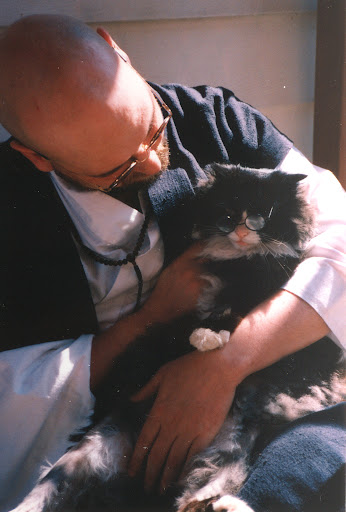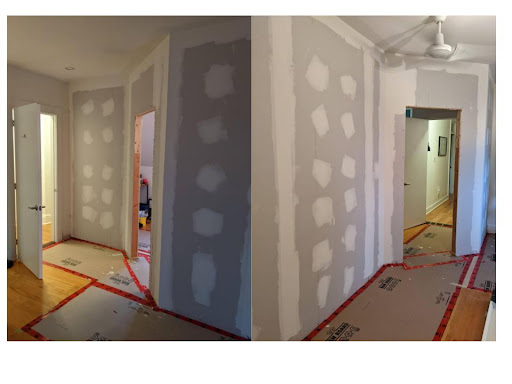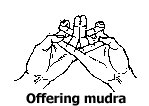
Ven. Anzan Hoshin roshi and his late friend Dai-un.
Photograph by the late Shikai Zuiko o-sensei, mid-1990s

Ven. Anzan Hoshin roshi and his late friend Dai-un.
Photograph by the late Shikai Zuiko o-sensei, mid-1990s
eMirror Vol 26, No. 36
Friday, September 2nd, 2022
Edited by the Practice Council
The White Wind Zen Community:
An international community practising and teaching Dogen’s Zen since 1985.
In the Zazen Yojinki, Keizan zenji says, “Composing poetry can be an aid in clarifying the mind but don’t get caught up in it. The same is true for writing and calligraphy. This is the superior precedent for practitioners of the Way and is the best way to harmonize the mind.”
When reading a poem or a novel, see with both eyes open. Hear the sound of turning the page, feel the paper with the fingers. Feel whole bodily, hear openly while reading. If you drink tea or burn incense or smoke or have music playing while you read then be open to the tastes and fragrances and sounds involved instead of letting them blur into a background. When you are reading a line, see the words above and below, the page, the space and forms and colours around the page. Notice when you are pushing your attention into a narrow identification with the characters or plot of a novel. A passage might bring forth some visceral or kinaesthetic response. For example, a character is being prepared for surgery and in the following paragraph the author begins to discuss the many many things that can go wrong and your breath tightens, perhaps the shoulders clench. “Oh no, don’t kill her off. It's only an appendix after all and Dirk doesn’t even know she’s in the hospital! It’s not fair!” This is fine, it means that the author wrote a “gripping” novel. But it is only a novel and you are reading it in your living room and it is seven thirty in the evening and isn’t it about time you sat? So bring those responses out into the open of your actual situation.
When reading a poem, do not forget that most poetry is written in the same way as a musical score has been written down. The poem is meant to be heard. Try reading it aloud. Feel the words, feel the breath, feel the tongue and teeth. And keep both eyes open. Play with the sounds of the words. Or just play with words and what is involved in speaking them. For example the word “involved.” In-volved. In-vol-v-ed. Whatever a wonderful series of sounds and the way in which they roll is almost an onomatopoeia for being involved. Ono-mato-poeia.
You can play with the meaning of words. Words have many many shades of meaning not only in the context in which they occur in a sentence but also in their history and origins. An example that I often use is the word “existence” which often has a meaning for people of something quite solid. However the Latin roots of the word are “ex-sistere.” “Ex” of course means “out” and “sistere means “to stand.” Thus when one says that something exists one might mean to say that there is a solid object in a world of solid objects out there which merely material mysticism and nonsense but what one is actually saying is that there is a standing forth or a standing out which makes perfect experiential and practical sense. You could find an etymological dictionary or bookmark a Web site and look into the origins of words that you are interested in.
And of course you could write a poem. If you have never written a poem before you might wind up with some doggerel like “We’ll all have fun, in the summer sun, eating a big bun, and then go for a run…” That is just fine. You have written a poem. It is terrible and it is not art but it is a poem. Now throw it out. And another one. And throw it out. Write thousands of poems and throw them all out. Explore how you use words. In the Zazen Yojinki Keizan zenji says, “If you wish to speak ten times, keep quiet nine; it’s as if moss grew over your mouth or like a fan in winter.” This is excellent advice for poetry. As with photography, what you choose to leave out makes what is present stand out.
-Ven Anzan Hoshin roshi, continuing Class Six: "The Mind Is Not 'The' Mind" in the series "Zen Arts: The Flowering of the Senses", October 1999 Daruma-ki O-sesshin, Dainen-ji.
Fusatsu: September 7th and 28th.
September Two-day Sesshin:
The September two-day sesshin will begin on Friday, September 9th at 8:00 p.m. and will end on Sunday the 11th at 6:00 P.M.
Hermitage:
The Roshi is currently in an extended period of "self-isolation" due to underlying health issues until the COVID-19 situation clarifies.
Beginning Instruction in Zen Practice:
For information concerning our Long-distance Training Program, please visit this Web Page: https://wwzc.org/long-distance-training-program
Rev. Chiso anagarika sat her weekly semi-retreat on Tuesday, August 30th at her home in the Berkshires. Robin Whitehead sat a half-day retreat on Monday, August 29th at Dainen-ji.
If you would like to sit a retreat at home please follow the schedule outlined in this page: https://wwzc.org/retreat-schedule-public-students. After your retreat, please send an email to schedule@wwzc.org to confirm that you sat a retreat and include the duration and location.
Although the monastery is not open to associate and general students for scheduled sittings, if you would like to sit a retreat at Dainen-ji, that is now possible.
You would need to schedule your retreat a week in advance. You will also need to get a rapid antigen Covid test done the day before you arrive and email us to let us know that you are Covid negative.
You will need to wear an N-95 mask while in the monastery. This link will let you know where you can pick up a free rapid antigen test https://covid-19.ontario.ca/rapid-test-locator
During the retreat, where the timing occurs along with scheduled sittings, you would join monastics and formal students in the Hatto on the second floor and wear a mask as we all do. During the other periods, you would sit in the Zendo on the first floor and would not wear a mask unless there are other students present.
You can sit a partial retreat, half-day retreat or full retreat for one or more days (providing you stay in the monastery and do not leave). The duration of retreats is as follows:
Half-day Retreat
You would need to arrive 15 minutes before the actual starting time. Begin at 6:00 a.m., end at noon. Or begin at 9:30 a.m., end at 6:00. Or begin at 3:00 p.m., end at 9:10.
Partial Retreat
You would need to arrive 15 minutes before the actual starting time. Begin at 6:00 a.m., end at 6:00 p.m. Or begin at 9:30 a.m., end at 9:10 p.m.
Full retreat
You would need to arrive by 5:45 a.m. Begin at 6:00 a.m., end at 9:10 p.m.
Please remember to bring a change of clothes suitable for samu (caretaking practice). If staying overnight, please remember to bring a sleeping bag, a towel and other such necessities. If you have been diagnosed by a medical doctor as having allergies to specific foods, please contact the tenzo-anja, mishin godo at mishin at gmail dot com, a week in advance of your retreat to inform her of dietary restrictions as this affects food purchases and meal planning. The suggested dana for retreats is $50 for a full day or $40 for a partial day, which covers the basic cost of food and other materials. Donations above this figure are very welcome and all donations are tax deductible.
If you would like to schedule a retreat, please send an email to schedule@wwzc.org.
On Saturday, August 27th and Sunday, August 28th we held a late summer Samu Weekend to work on various projects in the grounds and inside the monastery and 21 students attended over the two days. Here are some of the highlights of the many tasks that were completed. In the grounds more landscaping was done on the west side of the front garden in preparation for planting a new yew hedge in the spring of next year. We also temporarily removed the metal fence sections on the east side of the building so that a landscaping company will be able to easily remove the tall cedar hedge in a couple of weeks time, also so that we can plant more Yew trees in the spring to match the front yew hedge. The grape vines at the rear of the building and at the side area were trimmed as was Boston ivy to remove it from some windows. Lots of tidying and organisation was done in the shed, under the porches and at the car parking area. On the rear porch a recycling centre was built to make the storage of our recycling garbage easier and free up some more space in the basement pantry. In the kitchen the unused stove was removed and the lower section of the baking area was dismantled to allow a more usable storage system to be built. Extensive cleaning was also done in the kitchen. Various small improvements were made in the Shuryo and the door to the guest room next to the Shuryo was painted. Work was done to make further improvements to the doorbell system in the building and the extensive archives were brought down from the attic to the archiving room and organised as part of a reorganisation of the attic rooms.
Thank you to Jinmyo sensei for the really lovely midday meals enjoyed by those students who stayed for the full day of work and to the following students for offering their time to work on improving and maintaining the practice environment of Dainen-ji: Mishin godo, Fushin shuso, Senbo, Leonardo Nobrega, David Gallant, Shigemi Ichino, Kathleen Johnson, George Donovan, Micheal Gallant, Mario Delilse, Artik Chauhan, Eric Cyr, Jesse Steinburg, Don Charette, Sam McFarlane, Greg Parker, Robert Carew, Loic-Alexandre Ouellette, Giovanni Boulay and Rowan Russel.

Two views of the new room, with the drywall installed and mudding started.
We are in the process of building a new room in the monastery which will be available for rent in the Autumn. If you would like to engage in a period of long-term training, please contact Mishin godo at mishin@gmail.com for further details.
It is recommended for students thinking of moving into the monastery to engage in a period of temporary residential training (a week, two weeks, a month or so) before making the decision to move in permanently. Students living in the monastery are required to attend all of the scheduled sittings, so you need to be practising as a general student to meet this requirement.
Saturday, September 3rd to Saturday, September 10th
Saturday, September 3rd: “Wild Time: Zen Master Anzan Hoshin's commentaries on “Uji: Being Time” by Eihei Dogen zenji: “The Absolute Moment" (4 of 13)
Sunday, September 4th: SAkN "The Anatomy of Awakening" by Ven. Anzan Hoshin roshi: "Living the Body" (2 of 9)
Monday, September 5th: Hekiganroku 25: "Rengeho's Staff" by Ven. Anzan Hoshin roshi
Thursday, September 8th: "The Meaning of Mindfulness" by Ven. Jinmyo Renge sensei
Saturday, September 10th: “Wild Time: Zen Master Anzan Hoshin's commentaries on “Uji: Being Time” by Eihei Dogen zenji: “Wild" (5 of 13)
Associate and general students should continue to follow the recorded Teachings schedule for the sitting you were attending at the monastery, and listen to that during your home practice.
You can access the online Recorded Teachings Library at wwzc.org/recorded-teachings-schedule.
You can also use the streaming site at app.wwzc.org to live stream recordings from the online Library. If you have forgotten your password or need assistance with accessing the recorded Teachings, please email schedule@wwzc.org.
Please note that teisho should be listened to in the correct order and with none missed out as themes, metaphors, questions raised and answered evolve in spirals throughout the series.
While most of the online Recorded Teachings library is password-protected and only accessible to students of the Lineage of Zen Master Anzan Hoshin, a small selection of MP3 recordings of teisho are accessible to the public at wwzc.org/recorded-teachings Additional recordings will be uploaded periodically. MP3 recordings of four recorded teisho by Ven. Anzan Hoshin roshi are currently available:
Dharma Position https://wwzc.org/dharma-position
Eyes See, Ears Hear https://wwzc.org/eyes-see-ears-hear
Embarrassment https://wwzc.org/embarrassment
Ven. Anzan Hoshin roshi's reading of his translation of Eihei Dogen zenji's “Bendowa: A Talk on Exerting the Way”: https://wwzc.org/bendowa-talk-exerting-way

Photograph of Ven. Anzan Hoshin roshi at Daijozan, mid-1980s,
by Ven. Shikai Zuiko sensei
Ven. Anzan Hoshin roshi has recently completed translation work on some shorter texts by Eihei Dogen zenji from the Shobogenzo. The work on these particular texts is based upon the literal translations that he worked on with Joshu Dainen roshi at Hakukaze-ji around 1977-78 followed by many years of putting them down, picking them up, and polishing. Naturally, more essential texts such as Uji, Genjokoan, Shinjin Gakudo and some 40 others were completed first and have been given extensive commentaries by the Roshi. This batch of texts includes Baike: Plum Blossoms, Ryugin: Howling Dragon, and Udonge: The Udumbara Blossoming and many others are nearing completion. Annotation details and successfully conveying them across various document formats are the issue at this point.
Work on Bussho: Buddha Nature, a very long and nuanced text by Dogen zenji, is ongoing.
Roshi is also finishing an update to the Saijo Shingi: The Deportment of Radiance, our manual of monastic training standards which is a supplement to the ancient Eihei Shingi and Keizan Shingi.
Begun by Ven. Shikai Zuiko o-sensei
Finished by Rev. Fushin Comeau shramon following her death

Tengo (J): Turning word or phrase. Pivotal teaching. In a koan, the word or phrase that the issue of the koan hangs on and that must be penetrated and then expressed by the student.
Posted August 26th, 2022. New entries are posted every two weeks.

The Gokan-no-ge Meal Chant
Dogen zenji taught in the Tenzo kyokun: Instructions for the Tenzo (https://wwzc.org/dharma-text/tenzo-kyokun-instructions-tenzo) that the work of preparing and serving meals is "a matter for realized monks who have the mind of the Way “, or by senior disciples who have roused the Way-seeking mind." In alignment with this, part of Zen Master Anzan Hoshin's samu for the Community involves personally overseeing the activities of the ancient office of tenzo. Ven. Jinmyo Renge sensei serves as tenzo and Mishin godo and Saigyo ino offer assistance as tenzo-anja. The following meals were prepared on Monday, Tuesday and Thursday evenings for residents:
Monday Yakuseki:
Warm naan with butter; caramelised onion frittata topped with sliced tomatoes and grated Friulano cheese; salad of Romaine lettuce, leaf lettuce, radicchio, chopped celery, tomatoes, radishes and thinly sliced white onion; choice of balsamic vinaigrette or mustard/mayonnaise/apple cider vinegar dressing.
Tuesday Yakuseki:
Thai curry (reduced coconut milk, lime juice, red Thai curry paste, bamboo shoots, chopped poblano and anaheim peppers from the monastery garden, chopped white onion and leeks, baby bok choy).
Vegetarian option: tofu added to the curry.
For those who wished to supplement their diet with meat: cooked chunks of velveted’ chicken breast.
Salad of Romaine and leaf lettuce with cherry tomatoes from the roof garden.
Thursday Yakuseki:
Chinese rice cooked with corn (sheared fresh corn cooked with Chinese rice, with the cobs cut into sections and cooked on top of the rice in the rice cooker. The cobs were removed before serving, but added flavour to the rice); tempeh and sliced semi-firm tofu deep-fried in a batter made from all purpose flour, rice flour (for crispiness), grated garlic, minced scallions and Thai bird chilies; dipping sauce made from shoyu, Kecap manis (sweetened Indonesian shoyu) and minced Thai chilies; baechu kimchi.

If you would like to thank someone for a contribution they have made, please feel free to send an email to Jinmyo sensei at rengezo@gmail dot com, but be sure to type "eMirror” in the subject line.
From Gillian Hern:
Thank you to the Roshi and monastics for the ability to have long-distance training when living afar and during a pandemic. Thank you to Jinmyo sensei for the recorded series of Dharma talks “The Touchstone”. Thank you to Mishin godo and Saigyo ino for regular telephone practice advice, or at least trying to pin me down to a regular telephone schedule. Thank you to Mishin Godo for assistance in replacing my much loved, often repaired, and decidedly ageing zafu and zabuton with new ones that look similar, but newer.
From Claude Schryer:
I’m no longer a student at the monastery but enjoy reading the e-Mirror and wanted to thank Ven. Jinmyo Renge sensei for editing this valuable resource and to Ven Anzan Hoshin roshi for his weekly excerpts, which always make me want to continue my practice.
|